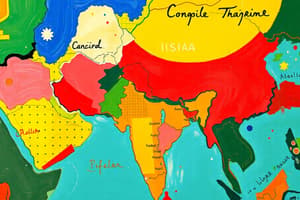Podcast
Questions and Answers
What significant role was Robert Clive appointed to by the Mughal emperor Shah Alam-III?
What significant role was Robert Clive appointed to by the Mughal emperor Shah Alam-III?
Which policy or method did the British East India Company employ to ensure revenue generation in Bengal?
Which policy or method did the British East India Company employ to ensure revenue generation in Bengal?
What transformation did the East India Company undergo as a result of acquiring territorial control in India?
What transformation did the East India Company undergo as a result of acquiring territorial control in India?
What was one of the challenges faced with nij cultivation for indigo?
What was one of the challenges faced with nij cultivation for indigo?
Signup and view all the answers
What event marked the beginning of the British East India Company's significant administrative role in Bengal?
What event marked the beginning of the British East India Company's significant administrative role in Bengal?
Signup and view all the answers
What was the primary goal of the Company in Bengal regarding its trade and revenue?
What was the primary goal of the Company in Bengal regarding its trade and revenue?
Signup and view all the answers
What significant event occurred in Bengal in 1770 that drastically affected the population?
What significant event occurred in Bengal in 1770 that drastically affected the population?
Signup and view all the answers
Which statement accurately describes the economic impact of the Company's policies on Bengal's economy?
Which statement accurately describes the economic impact of the Company's policies on Bengal's economy?
Signup and view all the answers
How did the Company transform its operations in Bengal following the establishment of the Permanent Settlement?
How did the Company transform its operations in Bengal following the establishment of the Permanent Settlement?
Signup and view all the answers
Which of the following best describes the Company's attitude towards the local rulers during its expansion in Bengal?
Which of the following best describes the Company's attitude towards the local rulers during its expansion in Bengal?
Signup and view all the answers
Study Notes
Introduction
- The East India Company started as a trading entity but evolved into a political power after acquiring vast territories in India.
- Significant administrative changes in Bengal were under Warren Hastings and Cornwallis, establishing a British-style governance system.
Ruling the Country Side
- Explores the historical changes in India under British rule until the mid-twentieth century.
Phase 1: The Company Becomes the Diwan
- On August 12, 1765, Robert Clive was appointed as the Diwan of Bengal, marking the Company as the chief financial administrator.
- The Company gained substantial revenue control and authority as it overhauled land policies, fostering power with caution.
Revenue for the Company
- The Company maintained its focus on trading while managing agricultural revenue for expenses.
- Revenue in Bengal doubled within five years after the Company's takeover; no regular assessment system was initially established.
Economic Crisis in Bengal
- British economic policies led to a decline in Bengal's economy, causing artisan migration and peasant inability to pay dues.
- By 1770, a famine resulted in the death of ten million people, which wiped out one-third of Bengal's population, affecting local markets severely.
The Need to Improve Agriculture
- Recognizing agricultural investment requirements, the Company introduced reforms, starting with the Permanent Settlement in 1793.
- Zamindars became responsible for collecting rents from peasants, expecting fixed revenue that would incentivize agricultural improvement.
Land Revenue Systems
- Three major systems existed under British rule: Zamindari, Mahalwari, and Ryotwari, distinguished by their land revenue payment methods.
A New System Is Devised
- By the early 1800s, a reinvention of revenue systems was necessitated; Holt Mackenzie designed the Mahalwari Settlement in 1822.
- This system involved village inspections with village headmen responsible for revenue collection, differing from zamindar control.
The Munro System
- Developed primarily in southern territories, the Ryotwari system provided incentives to individual farmers rather than zamindars.
- Indigo plantations proliferated due to rising demand and collapsing supply from other regions.
Britain Turns to India
- By 1810, 95% of British indigo imports originated from India, prompted by expanding cultivation in Bengal.
- The Company’s commercial agents invested heavily in indigo production, leading to a boom in the industry supported by loans for planters.
Indigo Cultivation Methods
- Two primary cultivation systems existed: Nij (direct land control) and Ryoti (tenant farmers).
- Nij faced challenges like land constraints and societal resistance from ryots, leading to widespread rebellion.
The Blue Rebellion
- In 1859, ryots revolted against planters with support from zamindars, seeing potential backing from the British government.
- The uprising attracted government attention, prompting investigations into coercive practices within indigo production.
- The Indigo Commission found planters guilty of exploiting ryots and declared indigo production unprofitable for them, allowing ryots to void contracts in the future.
Studying That Suits You
Use AI to generate personalized quizzes and flashcards to suit your learning preferences.
Related Documents
Description
Dive into the historical transformation of the East India Company and its administrative evolution in India. This quiz explores the significant changes brought about by the Company's growing territorial base and the shifts in its operations. Test your knowledge of early colonial history and administrative strategies.




